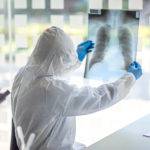Artificial intelligence to detect COVID-19 in less than a second using x-rays
Francisco Herrera, Computer Science Professor at the University of Granada, is leading research that aims to diagnose COVID-19 in less than a second using chest x-rays. The project, which is in advanced stages, uses artificial intelligence as a tool to interpret biomedical images more effectively than the human brain. This technique would greatly help health clinics that do not have sophisticated diagnostic imaging systems.

Herrera is the main researcher for the project ‘Deep Learning and Smart Data for Complex Problems’, which received a grant from the BBVA Foundation Grants for Scientific Research Teams in Big Data in 2018. “In this project supported by the foundation,” says Herrera, “on the one hand, we propose a theoretical line to understand how the smart machine works, and then, we propose its use to interpret images in different scenarios such as ecology and biodiversity studies or in the security field.”
With the spread of the pandemic, and thanks to his relationship with the radiology department at the San Cecilio University Hospital in Granada, Herrera felt that their project could offer solutions to help detect the disease quickly. “We decided to collaborate with the radiology team led by Dr. José Luís Martín to develop a smart system that could detect COVID-19 in an x-ray in tenths of a second,” he explains.
Herrera’s team has already confirmed the effectiveness of their system to read x-rays with greater precision than medical experts. According to data from the leading journal ‘Radiology’, radiologists are only able to detect 69 percent of COVID-19 cases in x-rays. The smart system Herrera is developing has already reached an accuracy level of 75 to 77 percent.

Francisco Herrera with his investigation team - BBVA Foundation
“The accuracy level we are obtaining with the system is already significantly higher than that of experts, but we are ambitious and want to perfect it to reach 80 percent before implementing it in clinics. We also want to perfect its performance to detect different scales of severity of pneumonia associated with COVID-19 in order to have success ratios over 90 percent for an incidence of moderate pneumonia in the lungs,” the researcher states.
Machine learning to perfect the system
In order to develop this technology, they worked with a database of 300 x-rays of patients with a positive diagnosis of COVID-19 and 300 more images of patients who do not have the disease. “All of our x-rays are validated by PCR test that have verified the presence of the disease in a patient,” explains Herrera. They are hoping to have a greater number of images to make the learning model more robust. “We want to base our system on a highly robust methodology and not celebrate prematurely,” he stresses.
However, Herrera is optimistic that he will be able to implement his system in the fall, prior to a possible second outbreak, if they reach the 80 percent threshold for accuracy. A technique that will be highly useful for health clinics in small cities that do not have sophisticated diagnostic imaging systems like CT scans. Implementing the system will allow a family doctor to reliably diagnose a case of COVID-19 with an x-ray in a matter of minutes, provided the patient’s lungs have been affected. “This way, the screening protocol for patients can be quickly activated, and affected patients isolated,” Herrera maintains.
This research is a new example of the tremendous potential of machine learning in the biomedical field as a scientific tool. Thanks to progress in this field, smart machines can now be trained to classify data sets with the same precision as humans, and occasionally superior to humans. For the researcher, “It has already been demonstrated that machines are superior to humans at analyzing biomedical images to diagnose skin cancer, as they are able to detect details that human experts cannot.” Nevertheless, this does not mean that they will replace experts, although “they could be a very useful tool to support decision-making, with the advantage of the analysis system’s speed.”